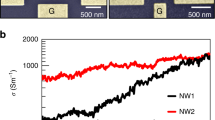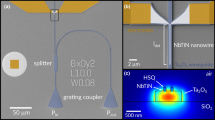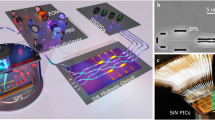Abstract
Photon-triggered electronic circuits have been a long-standing goal of photonics. Recent demonstrations include either all-optical transistors in which photons control other photons1,2 or phototransistors with the gate response tuned or enhanced by photons3,4,5. However, only a few studies report on devices in which electronic currents are optically switched and amplified without an electrical gate. Here we show photon-triggered nanowire (NW) transistors, photon-triggered NW logic gates and a single NW photodetection system. NWs are synthesized with long crystalline silicon (CSi) segments connected by short porous silicon (PSi) segments. In a fabricated device, the electrical contacts on both ends of the NW are connected to a single PSi segment in the middle. Exposing the PSi segment to light triggers a current in the NW with a high on/off ratio of >8 × 106. A device that contains two PSi segments along the NW can be triggered using two independent optical input signals. Using localized pump lasers, we demonstrate photon-triggered logic gates including AND, OR and NAND gates. A photon-triggered NW transistor of diameter 25 nm with a single 100 nm PSi segment requires less than 300 pW of power. Furthermore, we take advantage of the high photosensitivity and fabricate a submicrometre-resolution photodetection system. Photon-triggered transistors offer a new venue towards multifunctional device applications such as programmable logic elements and ultrasensitive photodetectors.
This is a preview of subscription content, access via your institution
Access options
Access Nature and 54 other Nature Portfolio journals
Get Nature+, our best-value online-access subscription
$29.99 / 30 days
cancel any time
Subscribe to this journal
Receive 12 print issues and online access
$259.00 per year
only $21.58 per issue
Buy this article
- Purchase on Springer Link
- Instant access to full article PDF
Prices may be subject to local taxes which are calculated during checkout




Similar content being viewed by others
References
Chen, W. et al. All-optical switch and transistor gated by one stored photon. Science 341, 768–770 (2013).
Fushman, I. et al. Controlled phase shifts with a single quantum dot. Science 320, 769–772 (2008).
Yu, H. et al. High-gain infrared-to-visible upconversion light-emitting phototransistors. Nat. Photon. 10, 129–134 (2016).
Park, S. et al. Significant enhancement of infrared photodetector sensitivity using a semiconducting single-walled carbon nanotube/C60 phototransistor. Adv. Mater. 27, 759–765 (2015).
Konstantatos, G. et al. Hybrid graphene–quantum dot phototransistors with ultrahigh gain. Nat. Nanotech. 7, 363–368 (2012).
Bisi, O., Ossicini, S. & Pavesi, L. Porous silicon: a quantum sponge structure for silicon based optoelectronics. Surf. Sci. Rep. 38, 1–126 (2000).
Godefroo, S. et al. Classification and control of the origin of photoluminescence from Si nanocrystals. Nat. Nanotech. 3, 174–178 (2008).
Tian, B. et al. Three-dimensional, flexible nanoscale field-effect transistors as localized bioprobes. Science 329, 830–834 (2010).
Zheng, G., Lu, W. & Lieber, C. M. Synthesis and fabrication of high-performance n-type silicon nanowire transistors. Adv. Mater. 16, 1890–1893 (2004).
Kim, J., Rhu, H. & Lee, W. A continuous process for Si nanowires with prescribed lengths. J. Mater. Chem. 21, 15889–15894 (2011).
Hochbaum, A. I., Gargas, D., Hwang, Y. J. & Yang, P. Single crystalline mesoporous silicon nanowires. Nano Lett. 9, 3550–3554 (2009).
Wolkin, M. V., Jorne, J., Fauchet, P. M., Allan, G. & Delerue, C. Electronic states and luminescence in porous silicon quantum dots: the role of oxygen. Phys. Rev. Lett. 82, 197–200 (1999).
Qu, Y. et al. Electrically conductive and optically active porous silicon nanowires. Nano Lett. 9, 4539–4543 (2009).
Soci, C. et al. ZnO nanowire UV photodetectors with high internal gain. Nano Lett. 7, 1003–1009 (2007).
Lu, W., Xie, P. & Lieber, C. M. Nanowire transistor performance limits and applications. IEEE Trans. Electron Dev. 55, 2859–2876 (2008).
Jin, S. et al. Scalable interconnection and integration of nanowire devices without registration. Nano Lett. 4, 915–919 (2004).
Luo, L.-B. et al. Light trapping and surface plasmon enhanced high-performance NIR photodetector. Sci. Rep. 4, 3914 (2014).
Mulazimoglu, E. et al. Silicon nanowire network metal–semiconductor–metal photodetectors. Appl. Phys. Lett. 103, 083114 (2013).
Tian, B. et al. Coaxial silicon nanowires as solar cells and nanoelectronic power sources. Nature 449, 885–889 (2007).
Huang, Y. et al. Logic gates and computation from assembled nanowire building blocks. Science 294, 1313–1317 (2001).
Yan, H. et al. Programmable nanowire circuits for nanoprocessors. Nature 470, 240–244 (2011).
Huang, Z., Fang, H. & Zhu, J. Fabrication of silicon nanowire arrays with controlled diameter, length, and density. Adv. Mater. 19, 744–748 (2007).
Acknowledgements
The authors thank J.-H. Song and M.-K. Seo for helping to build the experimental set-up. This work was supported by the National Research Foundation of Korea (NRF) grant funded by the Korean government (MSIP) (nos. 2009-0081565 and 2014M3A6B3063710). S.-H.K. acknowledges the support of an NRF grant (NRF-2016R1C1B2007007).
Author information
Authors and Affiliations
Contributions
J.K. and H.-G.P. designed the experiments. J.K., M.-S.H., J.-P.S., J.-H.C. and H.-G.P. built the experimental set-up. J.K., H.-C.L., J.-S.P. and J.M.L. performed the experiments. K.-H.K., S.-H.K. and C.J.B. performed the theoretical analyses. J.K., C.J.B. and H.-G.P. wrote the manuscript. All the authors discussed the results and commented on the manuscript.
Corresponding author
Ethics declarations
Competing interests
The authors declare no competing financial interests.
Supplementary information
Supplementary information
Supplementary Information (PDF 696 kb)
Rights and permissions
About this article
Cite this article
Kim, J., Lee, HC., Kim, KH. et al. Photon-triggered nanowire transistors. Nature Nanotech 12, 963–968 (2017). https://doi.org/10.1038/nnano.2017.153
Received:
Accepted:
Published:
Issue Date:
DOI: https://doi.org/10.1038/nnano.2017.153
This article is cited by
-
On-chip optoelectronic logic gates operating in the telecom band
Nature Photonics (2024)
-
All-in-one, all-optical logic gates using liquid metal plasmon nonlinearity
Nature Communications (2024)
-
Nanograin network memory with reconfigurable percolation paths for synaptic interactions
Light: Science & Applications (2023)
-
Perovskite multifunctional logic gates via bipolar photoresponse of single photodetector
Nature Communications (2022)
-
Surface deformation-dependent mechanical properties of bending nanowires: an ab initio core-shell model
Applied Mathematics and Mechanics (2022)



